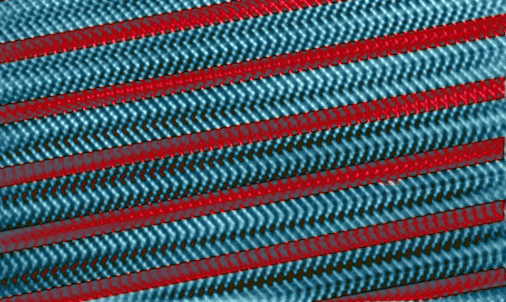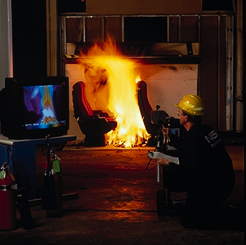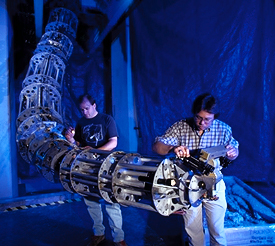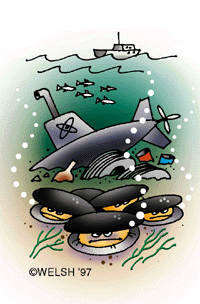|
|||
| Technology at a Glance is a quarterly newsletter from the National Institute of Standards and Technology reporting on research results, funding programs, and manufacturing extension and technology services. If you have comments or general questions about this newsletter or if you would like to receive the four-page, color newsletter in hard copy, please email your mailing address to Gail Porter, editor, or call (301) 975-3392. About Technology at a Glance. | |||
In this Issue . . .Articles: |
Shorts: Not Your Average Reference Materials The Hunt for Interstellar Iron Four Companies Win Baldrige Award Pass the DNA Chips Co-op
Corner: |
||
NIST Physicist Shares Nobel Prize |
|||
 ©1997 Robert Rathe ©1997 Robert Rathe
NIST Fellow William D. Phillips has been selected as a co-winner of the 1997 Nobel Prize in Physics. (See photo above.) Phillips shared the award with Steven Chu of Stanford University and Claude Cohen-Tannoudji, Collège de France and École Normale Supérieure of Paris. The Royal Swedish Academy selected the trio for work they did independently on the development of methods to cool and trap atoms with laser light. Phillips is the first NIST employee to win the Nobel Prize in the agency’s history. “I am thrilled to share in this prize,” said Phillips. “My colleagues in this field have influenced me profoundly and given me an enormous amount of help and stimulation. The research honored by this prize is the result of a huge effort by many other people. The vitality of the research environment at NIST and the scientific quality of my group have been essential to what we have accomplished.” Phillips began his work on laser cooling methods shortly after arriving at NIST in 1978. The technique involves focusing intersecting beams of laser light on a cloud of gas atoms under high vacuum. The laser radiation gently “pushes” on the atoms from opposite directions until the atoms come to a virtual standstill. In the late 1980s, Phillips’ research team demonstrated that laser cooling could refrigerate atoms well below the then-accepted limits, down to a few micoKelvins, or just a few millionths of a degree above absolute zero. Phillips and his colleagues at NIST in both
Gaithersburg, Md., and Boulder, Colo., are continuing to
study ultra-cold trapped atoms with the goal of pushing
the frontiers of precision measurement. Their work has
led to improved accuracy for atomic clocks, to the
creation of the Bose-Einstein condensates or
“superatoms,” and to new fields of study,
including atom optics and atom lasers. It also may have
future application in the development of more sensitive
gyroscopes for navigation and atom imaging systems for
fabricating ultra-small electronic components. Contact: Katharine Gebbie, (301)
975-4200. See also http://physics.nist.gov/News/contents.html
|
|||
Kammer Confirmed As NIST DirectorFollowing U.S. Senate confirmation, Raymond Kammer has been sworn in as NIST’s 11th director. Kammer, 50, was nominated by President Clinton in September to succeed Arati Prabhakar, who resigned in March to join the private sector. Kammer, the deputy director of NIST (from 1980 to 1991 and from 1993 to the present), most recently has been serving on an acting basis as chief financial officer, assistant secretary for administration, and chief information officer for the Department of Commerce. From 1991 to 1993, Kammer was deputy under secretary of commerce for oceans and atmosphere, the chief operating officer of the National Oceanic and Atmospheric Administration. He began his career with Commerce in 1969 as a program analyst. Prior to his appointment as NIST deputy director, Kammer held a number of management positions at NIST and Commerce involving budgetary and program analysis, planning, and personnel management. During his tenure as NIST deputy director, he also served as acting director of NIST, acting director of the National Measurement Laboratory, and acting director of the Advanced Technology Program. Contact: Public and Business Affairs, (301) 975-2762. |
|||
New Material Likes the Layered Look
The researchers are hoping that the layered materials may be useful for several applications, including heads for reading magnetic data on computer disk drives, high-density magnetic data storage, and focusing elements for neutron beams. Recently read heads made with many precisely sized layers of magnetic/non-magnetic materials have come on the market that are more sensitive to magnetic spin changes and thus can read data bits packed more closely together. Currently, these high-tech read heads are made by an expensive process in which each layer is sputtered onto a surface. In such artificial multilayers it is difficult to control the structure of interfaces. The new oxide material may provide a less expensive, more uniform way to make these layered structures. NIST researchers found that by heating mixtures of BaO-TiO2-Fe2O3 with different ratios of components, they could produce new materials with alternating magnetic and non-magnetic layers of varying thicknesses. The colorized transmission electron micrograph above shows an example of one of the layered structures. The blue layers are a non-magnetic phase (BaTiO3) and are about 2.1 nm thick. The red layers are a magnetic, iron-rich phase and are about 0.9 nm thick. Contact: Leo Bendersky, (301) 975-6167.
|
|||
Awards Speed Up R&D ProcessCost-shared awards provided by NIST’s Advanced Technology Program directly to industry are reducing the technology development cycle by about 50 percent, according to a new study of early ATP award winners. Most companies surveyed estimated that participation in the ATP reduced a typical 6-year technology development process to 3 years, with an economic impact of 1 million to several billions of dollars for a single year of time saved. The results are documented in a detailed survey of 28 teams funded by the ATP in 1991. Eighty-four percent of the interviewees expected that the time savings in R&D would be carried forward through product development, production, and marketing, enabling them to move the new technology into the marketplace more quickly. Details of the study, conducted by industry consultant
Frances Laidlaw, are provided in Acceleration of
Technology Development by the Advanced Technology
Program: The Experience of 28 Projects Funded in 1991 (NISTIR-6047).
Copies of the report are available from the ATP
Economic Assessment Office, (301) 975-4332, email: atp@nist.gov. |
|||
A Fresh Look at Train Fire Safety
©1997 Robert Rathe When a fire starts in a passenger train compartment, time is of the essence. The design of the compartment—from the materials used for curtains, seats, and carpets to the number of exits and the width of aisles—determines whether passengers will have enough time to exit the train car safely. As part of a 3-year study of passenger train fire safety requirements for the Federal Railroad Administration (under the direction of the Volpe National Transportation Systems Center), NIST researchers recently conducted full-scale tests in its large-scale fire research facility. Using bags of trash collected from in-service trains, NIST researchers measured heat release rates to better understand the behavior of realistic fires. The researchers are using these measurements with computer models to simulate how fires might spread in actual trains. Because these simulations take materials interactions and the size and arrangement of railway cars into account, they often can produce more realistic predictions of fire spread than materials testing alone. In the photo above, NIST fire protection engineer David Stroup uses an infrared camera to explore details of fire spread and burning of a trash fire set near train seats. Colors on the video monitor in the foreground are related to temperatures. White areas in the flame are hottest, followed by red, orange, yellow, green, and blue. Even when exposed to very intense, direct flames,
these train seats charred rather than igniting and
feeding the fire. In real world situations, these
high-performance materials help slow the spread of fire,
allowing more time for passengers to safely leave a
burning train car. Contact: Richard Peacock, (301)
975-6664. |
|||
Machines Team Up for Waste RemovalGreyPilgrim LLC, a Menlo Park, Calif., robotics startup, has teamed with NIST to prototype an innovative, remotely operated system for cleaning out underground nuclear waste storage tanks. The system combines the NIST-developed
RoboCrane—a mobile, spider-like crane that wields
cargo or tooling platforms while positioning them with
millimeter-level accuracy—with GreyPilgrim’s
EMMA (for Easily Manipulated Mechanical Armature). EMMA
is a long-reach manipulator, or robotic arm, that
resembles an elephant’s trunk in both appearance and
dexterity. (See photo below.) Its movements are
controlled by a set of steel cables that activate
individual stages in the arm. A 10-meter version is being
evaluated now at a NIST testbed. The arm supports a
45-kilogram payload at full reach and carries a waste
retrieval hose and an ultra-high-pressure waterjet for
dislodging stubborn waste.
Smaller EMMA prototypes have been demonstrated successfully with NIST’s 6-meter-tall RoboCrane. The unique crane provides a stable base that permits EMMA to move around inside a tank and to perform cleanup tasks. For nuclear waste retrieval, a 14- to 24-meter EMMA would be mounted to a larger version of the RoboCrane—big enough to straddle even underground tanks, which measure about 23 meters across and, therefore, avoid exerting forces on tanks of unknown structural integrity. The collaboration also provides NIST with an opportunity to refine advanced intelligent control concepts and to advance standards and measurement techniques for intelligent machine systems. Contact: Roger Bostelman, (301) 975-3426, or Robert Kent, (800) 365-3352. See also http://www.isd.mel.nist.gov/projects/robocrane/ |
|||
Composite Beams for Better BridgesComposites (hybrids of two or more materials) are attractive for infrastructure applications—bridges, buildings, and other large structures—because they are lightweight and resistant to rust and corrosion. Unfortunately, they also are expensive and difficult to engineer into structures of appropriate shape and size with adequate stiffness. Strongwell Corp., Bristol, Va., is designing and manufacturing bridge beams made of polymer composites that consist of glass and carbon fibers bound by a resin, which should last longer and be maintained more easily than the concrete and steel now used. Strongwell is using co-funding from the Advanced Technology Program to enhance the mechanical properties of the material, optimize beam shape, and establish design standards and load capacities. Working with the Georgia Institute of Technology, the company has designed and manufactured an 8-inch-high prototype bridge beam and continues to work toward production of a 36-inch-high beam. The project has attracted the interest of transportation officials in a number of states. In an offshoot to the ATP project, 24 subscale beams were installed successfully in the replacement of the Tom’s Creek Bridge in Blacksburg, Va., making it one of the first U.S. vehicular bridges to use hybrid composites as the primary load-bearing structure. Long-term field tests will indicate whether taxpayers can reap the expected benefits of reduced fabrication, installation, and maintenance costs and fewer traffic delays associated with bridge repair and replacement. Contact: Glenn Barefoot, (540) 645-8052. |
|||
Not Your Average Reference Materials
|
|||
The Hunt for Interstellar IronIf you’re hunting for something in the vast
emptiness of space between the stars, it helps to have
some idea where to look. Researchers at NIST, Oxford
University, and the University of Bonn recently made some
very precise measurements of absorption spectra for iron
deuteride (FeD2) that should help astronomers in their
quest to find the element iron in the cosmos. While iron
is a fairly common element on Earth, it’s never been
documented in interstellar space. The researchers used a
technique called laser magnetic resonance spectroscopy to
make exacting measurements of far-infrared light absorbed
by FeD2 during “vibrational bending.” The
measurements are the highest frequency, far-infrared
spectra of this type ever recorded. The team modified a
spectrometer to allow measurements at frequencies as high
as 9 terahertz. The improved instrument also should be
useful for measuring the so called “fine structure
spectra” of chlorine monoxide, which is an important
molecule in the atmospheric chemistry of ozone depletion.
Contact: Kenneth
Evenson, (303) 497-5129. |
|||
Four Companies Win Baldrige AwardTwo manufacturers—one for a second time—and
two service firms have won the 1997 Malcolm Baldrige
National Quality Award for their achievements in
quality and business performance. The awards, announced
by President Clinton and Department of Commerce Secretary
William Daley in October went to: 3M Dental Products
Division, St. Paul, Minn. (manufacturing); Solectron
Corp., Milpitas, Calif. (manufacturing); Merrill Lynch
Credit Corp., Jacksonville, Fla. (service); and Xerox
Business Services, Rochester, N.Y. (service). Solectron
also won the award in the manufacturing category in 1991.
Congress established the Baldrige Award in 1987; the
first awards were presented in 1988. The award's goals
are to enhance U.S. competitiveness by promoting quality
awareness, recognize quality and business achievements of
U.S. companies, and publicize these companies' successful
performance. It is not given for specific products or
services. For further information, visit the Baldrige
website at http://www.quality.nist.gov
or call (301) 975-2036. |
|||
Pass the DNA Chips
|
|||
Technology
Partnerships—Transgenic tobacco that can help
produce human insulin, information technologies that
bring artificial common sense to Internet searches, and
innovative manufacturing and materials technologies are
among the goals sought in 64
new industrial research projects announced recently
by NIST’s Advanced Technology Program. The awards
are the result of seven ATP competitions conducted in
1997. The majority of the awards, 48, went to small
businesses either for single company projects or as the
lead company in an industry joint venture. Contact: NIST Public and Business
Affairs, (301) 975-2758. Computer Security—NIST
and the National Security Agency have established the
National Information Assurance Partnership. The
partnership will employ the latest techniques to develop
product specification tools, testing methods, and tests
so that testing laboratories and organizations—as
well as consumers and producers of information technology
products—will have objective measures for evaluating
security products and systems. The NIAP has several
goals, including promoting demand and investment in
security-enhanced products; moving current evaluation and
testing efforts from the federal government to
accredited, private-sector laboratories; and fostering
research and development in security tests, test methods,
and metrics. Contact: Arnold Johnson, (301)
975-3247. Polishing Tool—Rodel Inc., Newark, Del., recently licensed a NIST invention for “lapping” and polishing high-precision parts. In a cooperative research effort with NIST, the University of Delaware, and six other organizations, the company plans to evaluate the tool's effectiveness for polishing photomasks used in making computer chips. The NIST system includes a porous ceramic form covered in a thin film, which can be replaced in seconds. This offers flexibility for small batch production and good repeatability for higher volume production. The ceramic substrate, overlying thin film, and abrasive can be tailored to a particular material or workpiece. In tests, the system removed material from glass, silicon, copper, and other workpieces at significantly better than average rates, while achieving high-quality surfaces. Contact: Chris Evans, (301) 975-3484. |
|||
About Technology at a Glance:NIST is an agency of the U.S. Department of Commerce's Technology Administration. NIST promotes U.S. economic growth by working with industry to develop and apply technology, measurements, and standards. Technology at a Glance is produced by Public and Business Affairs, A903 Administration Bldg., NIST, Gaithersburg, Md. 20899-0001. Any mention of commercial products is for information only; it does not imply recommendation or endorsement by NIST. Technology at a Glance Editor: Gail Porter, (301) 975-3392, email: gail.porter@nist.gov. For patent information, call (301) 975-3084. |
|||

 Mix a large group of middle school boys and
girls at a dance and they will naturally align
themselves—boys on one side, girls on the other.
NIST metallurgy and ceramics researchers have found two
different forms of a material that will do the same thing
in orderly fashion. When two types of
barium-titanium-iron-oxide with different crystal
structures and different concentrations of iron are
mixed, the two forms naturally align themselves into
magnetic and non-magnetic layers.
Mix a large group of middle school boys and
girls at a dance and they will naturally align
themselves—boys on one side, girls on the other.
NIST metallurgy and ceramics researchers have found two
different forms of a material that will do the same thing
in orderly fashion. When two types of
barium-titanium-iron-oxide with different crystal
structures and different concentrations of iron are
mixed, the two forms naturally align themselves into
magnetic and non-magnetic layers.

 NIST has added to its list of unusual
standard reference materials. Organics in Freeze-Dried
Mussel Tissue (SRM 2974) and Ocean Sediment
(Radioactivity) (SRM 4357) are now available to help
researchers ensure the accuracy of measurements and
better monitor the health of the ocean and its
inhabitants. NIST scientists chose mussels from Boston
Harbor for the new mussel tissue SRM to help marine
biologists accurately assess pollution in marine life.
The freeze-dried mussel tissue SRM includes certified
values for 47 toxic pollutants. To make the ocean
sediment SRM, radioactive materials were dredged from the
Irish Sea and diluted with Chesapeake Bay sediments.
Working with the United Kingdom’s National
Radiological Protection Board and 20 laboratories around
the world, NIST helped certify radioactivity levels for
10 natural and manmade radionuclides. The SRM will help
accurately monitor radiation levels in ocean beds such as
the Arctic, where nuclear reactors from submarines have
been disposed. Contact:
NIST has added to its list of unusual
standard reference materials. Organics in Freeze-Dried
Mussel Tissue (SRM 2974) and Ocean Sediment
(Radioactivity) (SRM 4357) are now available to help
researchers ensure the accuracy of measurements and
better monitor the health of the ocean and its
inhabitants. NIST scientists chose mussels from Boston
Harbor for the new mussel tissue SRM to help marine
biologists accurately assess pollution in marine life.
The freeze-dried mussel tissue SRM includes certified
values for 47 toxic pollutants. To make the ocean
sediment SRM, radioactive materials were dredged from the
Irish Sea and diluted with Chesapeake Bay sediments.
Working with the United Kingdom’s National
Radiological Protection Board and 20 laboratories around
the world, NIST helped certify radioactivity levels for
10 natural and manmade radionuclides. The SRM will help
accurately monitor radiation levels in ocean beds such as
the Arctic, where nuclear reactors from submarines have
been disposed. Contact:  They’re not too tasty with onion dip,
but DNA chips may revolutionize disease diagnosis, DNA
sequencing, environmental sampling, and other analytical
jobs. DNA chips are tiny integrated devices that use
fragments of “unzipped” DNA strands to quickly
identify bacteria, viruses, or genetic disease
“markers.” To support this emerging technology
(as well as a group of Advanced Technology Program awards
on Tools for DNA Diagnostics), NIST scientists are
studying the fundamental molecular structure of DNA chip
components. NIST scientists construct DNA chips from
single-stranded DNA molecules that are attached on one
end to a gold surface. The surface-tethered DNA then can
bind with complementary small fragments of
single-stranded DNA from a sample. The NIST research has
helped industry better understand how the DNA molecules
assemble on a surface and how to obtain the best coverage
of DNA for better sensitivity. DNA chips could become the
basis for very fast sensors to diagnose bacterial
infections in blood samples, to identify E. Coli
in ground beef, or check water samples for pfiesteria
piscicida. Contact:
They’re not too tasty with onion dip,
but DNA chips may revolutionize disease diagnosis, DNA
sequencing, environmental sampling, and other analytical
jobs. DNA chips are tiny integrated devices that use
fragments of “unzipped” DNA strands to quickly
identify bacteria, viruses, or genetic disease
“markers.” To support this emerging technology
(as well as a group of Advanced Technology Program awards
on Tools for DNA Diagnostics), NIST scientists are
studying the fundamental molecular structure of DNA chip
components. NIST scientists construct DNA chips from
single-stranded DNA molecules that are attached on one
end to a gold surface. The surface-tethered DNA then can
bind with complementary small fragments of
single-stranded DNA from a sample. The NIST research has
helped industry better understand how the DNA molecules
assemble on a surface and how to obtain the best coverage
of DNA for better sensitivity. DNA chips could become the
basis for very fast sensors to diagnose bacterial
infections in blood samples, to identify E. Coli
in ground beef, or check water samples for pfiesteria
piscicida. Contact: